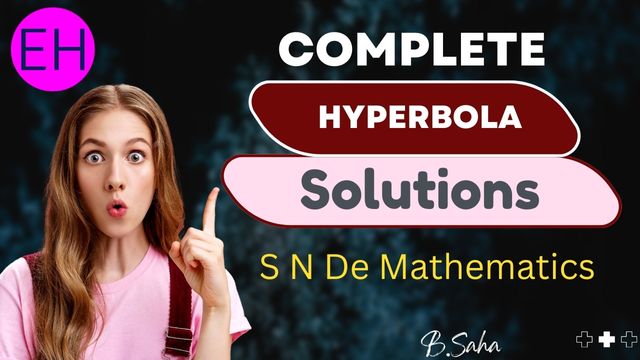Hyperbola (S.N.Dey) | Part-1 | Ex-6: In this article , we have solved a few Very Short Answer Type questions ( 1-8 ) of Hyperbola related problems of S N Dey mathematics class 11.
Hyperbola (S.N.Dey) | Part-2 | Ex-6 : In this article , we have solved a few Very Short Answer Type questions ( 9-14 ) of Hyperbola related problems of S N Dey mathematics class 11.
Hyperbola (S.N.Dey) | Part-3 | Ex-6 : In this article , we have solved a few Short Answer Type questions ( 1-3 ) of Hyperbola related problems of S N Dey mathematics class 11.
Errorless 45 Previous Years IIT JEE Advanced (1978 2022) + JEE Main (2013 2022) Physics, Chemistry & Mathematics Chapterwise & Topicwise Solved ... Solutions for JEE 2023Set of 3 Books Paperback
Hyperbola (S.N.Dey) | Part-4 | Ex-6 : In this article , we have solved a few more Short Answer Type questions ( 4-5 ) of Hyperbola related problems of S N Dey mathematics class 11.
Hyperbola (S.N.Dey) | Part-5 | Ex-6 : In this article , we have solved a few more Short Answer Type questions ( 6-17 ) of Hyperbola related problems of S N Dey mathematics class 11.
Hyperbola (S.N.Dey) | Part-6 | Ex-6 : In this article , we have solved Complete Long Answer Type questions ( 1-9 ) of Hyperbola related problems of S N Dey mathematics class 11.
Hyperbola: Exploring a Fascinating Mathematical Curve
Introduction:
In the vast realm of mathematics, the hyperbola stands out as an intriguing and captivating curve. The hyperbola, along with the ellipse and the parabola, is one of the three conic sections. Its distinct shape and unique properties make it a subject of extensive study in various branches of mathematics, physics, and engineering. In this article, we will delve into the world of hyperbolas, exploring their definition, properties, and practical applications.
Definition and Shape:
A hyperbola is defined as the set of all points in a plane such that the difference of their distances from two fixed points, called the foci, is constant. The shape of a hyperbola resembles two open curves that mirror each other symmetrically about a central axis. This axis, known as the transverse axis, intersects the two vertices of the hyperbola.
Properties and Characteristics:
Hyperbolas possess several key properties that distinguish them from other conic sections. Some of the notable characteristics of hyperbolas include:
Asymptotes: Hyperbolas have two asymptotes, which are straight lines that the curve approaches but never intersects. These asymptotes intersect at the center of the hyperbola and provide a framework for understanding the behavior of the curve.
Vertices: Hyperbolas have two vertices located on the transverse axis. The distance between the center and each vertex is known as the semi-transverse axis. This distance plays a significant role in defining the size and shape of the hyperbola.
Foci: The foci of a hyperbola are the two fixed points that define its shape. The distance between the foci is constant and is known as the focal length. Foci play a crucial role in determining the focus-directrix property of the hyperbola.
Eccentricity: Hyperbolas have an eccentricity greater than 1. The eccentricity quantifies the degree of "flatness" of the hyperbola and is a key parameter in its mathematical representation.
Oswaal JEE Advance 10 Mock Test Papers (Paper-1 & Paper-2) Physics, Chemistry, Mathematics (For 2023 Exam) Paperback
Applications:
The study of hyperbolas finds numerous practical applications across different fields. Some notable applications include:
Astrophysics: Hyperbolic trajectories are observed in celestial bodies, such as comets and spacecraft, which follow paths with sufficient energy to escape the gravitational pull of a central body.
Optics: Hyperbolic mirrors, known as hyperboloids, are used in certain optical systems to focus or direct light. They find applications in telescopes, radar systems, and satellite communications.
Architecture: Hyperbolic shapes and curves are employed in architectural design to create aesthetically pleasing and structurally stable structures, such as bridges and buildings.
Navigation and GPS: Hyperbolic navigation systems, such as LORAN (LOng RAnge Navigation), use hyperbolic curves to determine the location of a receiver by measuring the time differences between signals transmitted from multiple fixed stations.
Conclusion:
The hyperbola, with its distinctive shape and mathematical properties, offers a fascinating journey into the realm of conic sections. Its study expands our understanding of geometry, provides insights into celestial motion, and finds practical applications in various scientific and engineering disciplines. The intricate interplay of foci, vertices, and asymptotes within the hyperbola unveils a rich tapestry of mathematical beauty. Exploring the world of hyperbolas opens up a realm of possibilities for both theoretical exploration and real-world applications.












Please do not enter any spam link in the comment box